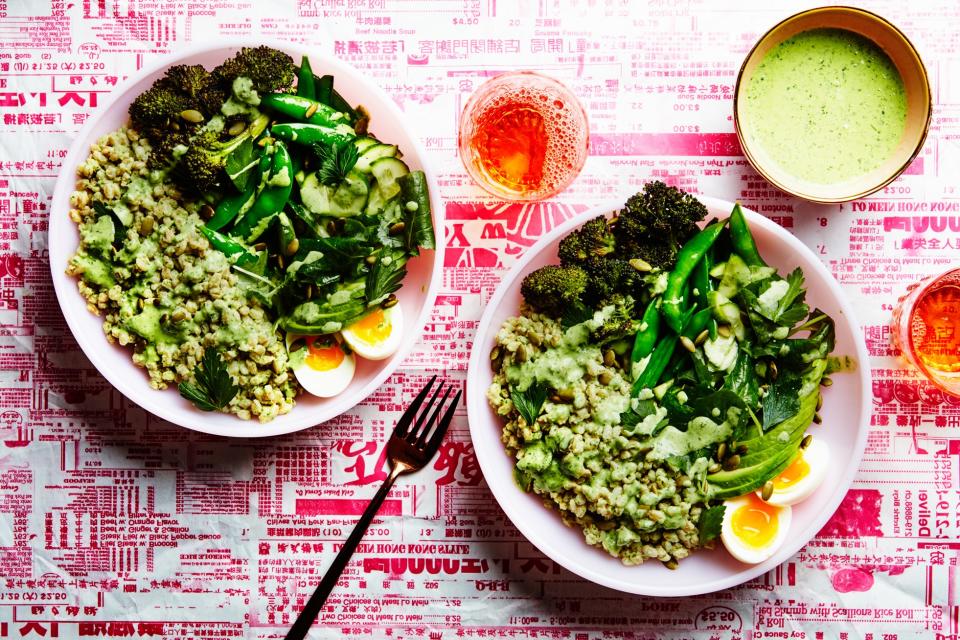How the Buddha Bowl Got Its Name
By Katherine Sacks. Photos by: Chelsea Kyle.
At some point late last year, every grain bowl transformed into a Buddha Bowl. It happened on restaurant menus, it happened on blogs, and it really, really happened on Pinterest.
As a big fan of eating macrobiotic—a diet that focuses on whole grains and steamed vegetables—this was a little confusing to me. I'd been down with the grain bowl for a while. Why were these bowls of veggies and grains now suddenly named Buddha? Were they doing it sun salutations and meditation when I wasn't looking?
Turns out, not quite.
I turned to the authors of Buddha's Diet, data scientist and Zen priest Dan Zigmond and digital strategist and wellness writer Tara Cottrell, to learn more about the obsession with putting Buddha in the bowl. Tagged "The Ancient Art of Losing Weight Without Losing Your Mind," the book focuses on our culture's fascination with mindfulness and eating.
"Food for Buddha was very low-key," says Cottrell, who explains Buddha was actually very thin. (Those chubby statues you see in Chinese restaurants are of a monk who lived a thousand years later.) "The key was to keep food in its place. He didn’t want food to take over our whole life."
The book—part diet book, part Zen-musings—does suggest eating as the Buddhists do, including intermittent fasting, regular weigh-ins, and a no-or-low-alcohol diet. But unlike most diet books, it offers no recipes, and instead provides suggestions and ideas for making shifts in daily practice in order to "eat on the Buddha diet" and lose weight.
"Buddha cared a lot more about when we eat than what we eat. His main rule around food for his followers was that they should eat only during certain hours," says Zigmond. "Buddhist monks and nuns have been eating this way for over two thousand years."
And while there's no specific mention of the trendy Buddha Bowl in Zigmond and Cottrell's book, the Buddha did eat from a bowl, which may have led to today's obsession with—or, rather, appropriation of—the term.
"Buddha woke up before dawn every morning and carried his bowl through the roads or paths wherever he was staying. Local people would place food in the bowl as a donation, and at the end he would eat whatever he had been given," explains Zigmond. "So that was the original Buddha Bowl: a big bowl of whatever food villagers had available and could afford to share. It was probably pretty healthy, since Buddha lived before the age of cheap processed food, but it was also probably pretty simple, maybe rice and a simple curry."
When it comes to eating their own Buddha Bowls, Zigmond and Cottrell have some strong opinions. " Here’s a dark secret: I hate quinoa," says Zigmond. "Quinoa is gross, as is kale. There are so many good vegetables in the world, why eat something that tastes like vinyl?" adds Cottrell. As far as prep, the mother of three likes to keep it super simple. "A lot of the Buddha bowl ideas I see on Pinterest involve quite a bit of prep and cooking. My version of a Buddha Bowl is whatever veggies are in the fridge, grilled up with a few spices. Sometimes simple gets the job done just fine."
For my most recent grain bowl (aka Buddha Bowl, aka the-way-I-eat-all-the-time-just-with-a-trendy-name), I've gone with Cottrell's advice and kept it simple AF. Use whatever grain you have on hand (brown rice is usually around, but lately I've been cooking farro), and all the green veggies you've got—roasted, steamed, raw, whatevs. The only real prep comes in making the tangy, herby Green Goddess dressing—which believe me, you'll want extras of. Toss the grains in the dressing, bowl it up with the veggies, drizzle on more dressing, and bam: suddenly, you'll be eating like Buddha, too.
Get this recipe: Green Goddess Buddha Bowl
This story originally appeared on Epicurious.
More from Epicurious:
11 Ingredients You Should NEVER Refrigerate
12 Lightning-Fast Chicken Dinners to Make Now


